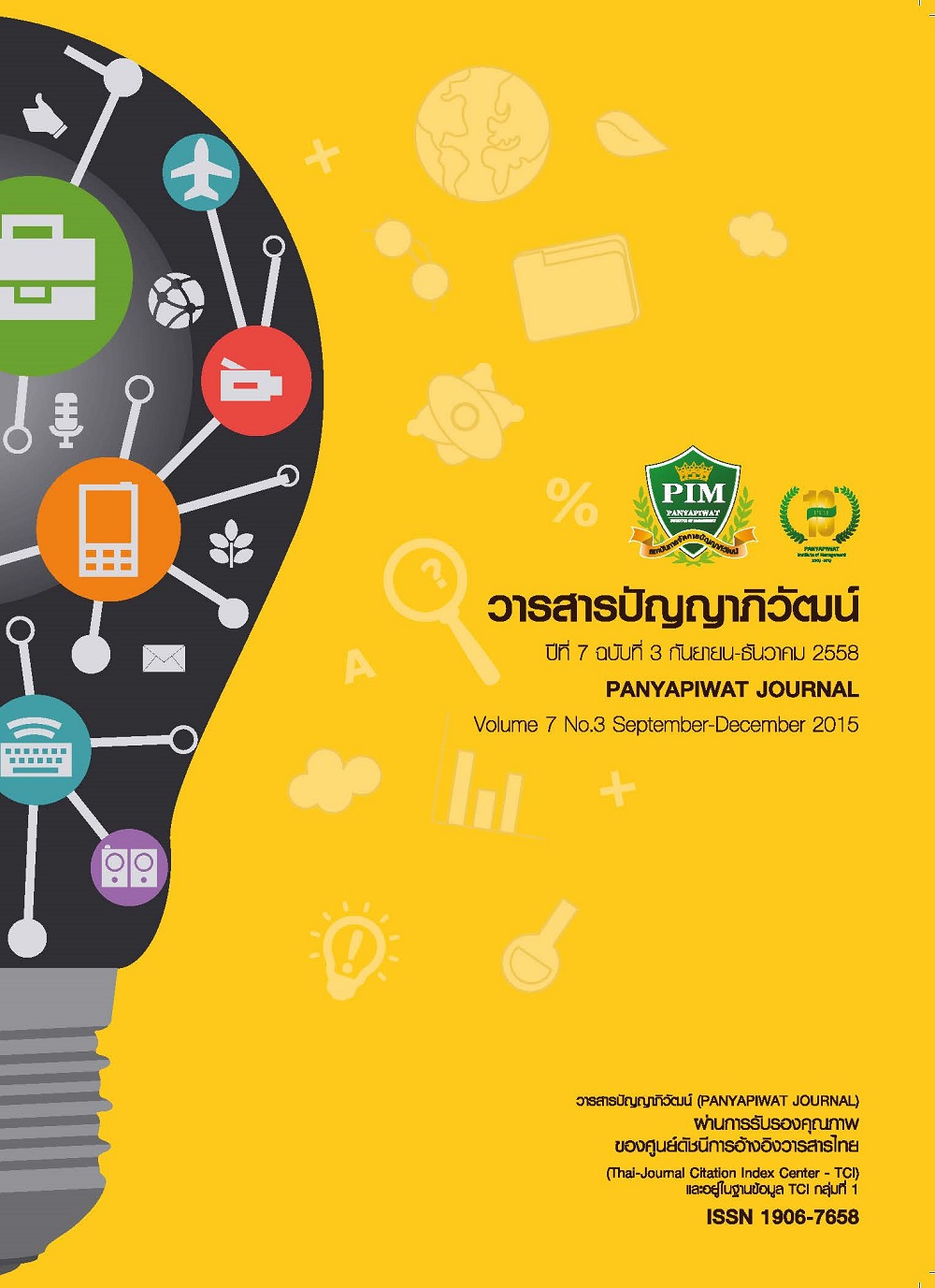GUIDELINES OF TEACHING FOR UNDERGRADUATE STUDENTS OF ENGLISH SUMMARY WRITING
Main Article Content
บทคัดย่อ
This article aims to guide for teaching students English summary writing. According to English summary writing, the students / summary writers always have problems when they summarized various information. The important problem is that the students / summary writers usually copy some part of original texts and paste into their drafts but the information is not relevant and the information in summarizing paper is not smooth for reading. Additionally, the summary writers have used this method when they studied in school and they might think that this action is correct and good for summary writing.
On the other hands, copying of information from original text is only used for selecting keywords, main idea and important information. Therefore, the students / summary writers should use reading techniques; skimming, scanning, taking note, re-reading and writing process when they summarized texts. However, the supporting details should be concise and used their own words for writing the summarizing papers. Thus, the summary writers should know definition of summary writing and what good characteristics of summary writing is. Hence, this writing article presents a method which suggests English teachers for teaching the students summarize texts.
บทความนี้มีวัตถุประสงค์เพื่อเสนอแนะการสอนนักศึกษาในการเขียนย่อความภาษาอังกฤษ เมื่อกล่าวถึงการเขียนย่อความภาษาอังกฤษ นักศึกษาหรือผู้เขียนย่อความมักจะพบปัญหาเมื่อเขียนย่อความข้อมูลต่างๆ ปัญหาสำคัญคือ นักศึกษาหรือผู้เขียนย่อความจะคัดลอกบางส่วนของต้นฉบับและตัดต่อลงในฉบับร่าง แต่ข้อมูลจะไม่มีความต่อเนื่องและข้อมูลนั้นไม่รื่นต่อการอ่าน นอกจากนั้นผู้เขียนย่อความยังใช้วิธีดังกล่าวตั้งแต่เรียนในระดับโรงเรียนและเขาอาจจะคิดวิธีที่ใช้เป็นวิธีที่ถูกต้องและดีสำหรับการเขียนย่อความ
ความเป็นจริงแล้วการคัดลอกข้อมูลจากต้นฉบับเป็นวิธีการเพื่อใช้ในการเลือกคำสำคัญ ความคิดหลักและข้อมูลสำคัญเท่านั้น ดังนั้นนักศึกษาหรือผู้เขียนย่อความควรใช้เทคนิคการอ่าน การอ่านแบบครอบคลุ่ม การอ่านแบบรายละเอียด การจดโน๊ต การอ่านทบทวน และกระบวนการการเขียน ในการเขียนย่อความ อย่างไรก็ตามรายละเอียดของเนื้อความควรจะถูกเขียนในรูปแบบย่อและใช้ภาษาของผู้เขียนเองสำหรับการเขียนย่อความ ผู้เขียนย่อความจึงควรรู้ถึงความหมายของการเขียนย่อความและความหมายของลักษณะของการเขียนย่อความที่ดี ดังนั้นบทความนี้จึงนำเสนอวิธีการแก่ครูสอนภาษาอังกฤษเพื่อการสอนนักศึกษาในการย่อความเนื้อความ
Article Details
“ข้าพเจ้าและผู้เขียนร่วม (ถ้ามี) ขอรับรองว่า บทความที่เสนอมานี้ยังไม่เคยได้รับการตีพิมพ์และไม่ได้อยู่ระหว่างกระบวนการพิจารณาลงตีพิมพ์ในวารสารหรือแหล่งเผยแพร่อื่นใด ข้าพเจ้าและผู้เขียนร่วมยอมรับหลักเกณฑ์การพิจารณาต้นฉบับ ทั้งยินยอมให้กองบรรณาธิการมีสิทธิ์พิจารณาและตรวจแก้ต้นฉบับได้ตามที่เห็นสมควร พร้อมนี้ขอมอบลิขสิทธิ์บทความที่ได้รับการตีพิมพ์ให้แก่สถาบันการจัดการปัญญาภิวัฒน์หากมีการฟ้องร้องเรื่องการละเมิดลิขสิทธิ์เกี่ยวกับภาพ กราฟ ข้อความส่วนใดส่วนหนึ่งและ/หรือข้อคิดเห็นที่ปรากฏในบทความข้าพเจ้าและผู้เขียนร่วมยินยอมรับผิดชอบแต่เพียงฝ่ายเดียว”
เอกสารอ้างอิง
Bean, J. C., Chappell, V. & Gillam, A. M. (2004). Characteristics of a Summary. Retrieved August 23, 2015, from About.com/od/rg/g/summaryterm.html
Byrne, D. (1982). Teaching Writing Skill: Contexts for writing: the use of texts. UK: Longman.
Caesar, J. (2012). Writing Summary: How long should my summary be?. Retrieved September 22,2012, from http://srjcwritingcenter.com/summaryies/summaryies.html
Cox, M., Harvey, C., A. & Page, S. E. (2007). The Library Media Specialist in the Writing Process. The Writing Process, Worthington, OH: Linworth Publishing, Inc.
Doyle, A. (2012). Writing Guide: Paraphrase and Summary. The University of Kansas, KU Writing Center.
Hamp-Lyons, L. & Heasley, B. (1993). Study Writing. Scotland: Cambridge University Press.
Harris, J. (1993). Introducing Writing. New Zealand: Penguin English.
Hedge, T. (2000). Teaching and Learning in the Language Classroom. Oxford: Oxford University Press.
Kennedy, M. L., Kennedy, W. J. & Smith, H. M. (2000). Writing in The Disciplines: A Reader For Writers. New Jersey: Prentice Hall.
Kroll, B. (1991). Second Language Writing: Research Insights for the Classroom. Cambridge: Cambridge University Press.
Langan, J. (1987). College Writing skills. Preparing A Summary. McGraw-Hill International Editions. English Language Series, 106, 203-205.
Mahathananont, S. & Phongphood, K. (1994). Teaching Material 3. Thailand Department of English. Thailand: Siam University.
Marsen, S. (2003). Professional Writing. The Complete Guide for business Industry and IT. Research and Information Management. New York: Palgrave Macmillan.
Northan, J. (2011). Writing a Lay Summary is Easy, Right?: Latest Research and Knowledge Exchange News. Retrieved September 22, 2012, from http://blogs.bournemouth.ac.uk/research
Palmer, B. C., Hafner, M. L. & Sharp, M. F. (1994). Developing Cultural Literacy Through the Writing Process. Boston: A Division of Paramount Publishing.
Pappas, C. C., Kiefer, B. Z. & Levstik, L. S. (1995). An Integrated Language Perspective in the Elementary School. New York: Longman Publishers.
Reid, S. (2000). The Prentice Hall Guide for College Writers. New Jersey: Prentice Hall Upper Saddle River.
Reid, S. (2003). Academic Writing: Writing the Summary: Definition and Basic Information. Characteristics of s Summary. Retrieved September 26, 2012, from http://www.academicdesk. org/2009/11/writing-summary-definiton-and basic.html
Semple, J. (2009). Writing the Summary: Definition and Basic Information. How to write a summary. Retrieved September 26, 2012, from http://www.academicdesk.org/2009/11/writing-summary-definiton-and basic.html
Smith, E. L. & Bernhardt, S. A. (1997). Writing at Work, Professional Writing Skills For People On The Job, NTC. USA: Lincolnwood.
Tribble. C. (1997). Writing. Oxford University Press, 18, 115.
Wehmeyer, D. (2012). Summary Writing, Learning activities help people succeed-find your success here. Retrieved June 14, 2012, from http://www.wisc-online.com/objects/ViewObject.aspx?ID=TRG2603
Wong, S. (1983). Summary Writing Principles and Practice. Singapore: Pan Pacific Book Distributors.
Wright, J. (2012). The Savvy Teacher's Guide: Reading Interventional That Work. Keywords: A Memorization Strategy. Retrieved September 25, 2012, from www.interventioncentral.org


